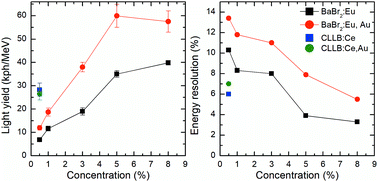Effect of AuBr3 additive on the scintillation properties of BaBr2:Eu and Cs2LiLaBr6:Ce
Abstract
Following the observation of large increases in light output of BaBrCl:Eu single crystals using AuBr3 as an additive in the melt, the impact of this process on the scintillation properties of other Br-based scintillating materials is investigated in an attempt to assess its broader use. Results for Cs2LiLaBr6:Ce and BaBr2:Eu single crystals with various Ce and Eu concentrations are presented. The results indicate that such an additive has very different effects in the two investigated materials. Although AuBr3 is not incorporated in the two crystalline matrices, it increases remarkably, by up to a factor 2, the light yield of BaBr2:Eu in a similar manner to that observed for BaBrCl:Eu, but is at best ineffective in the case of Cs2LiLaBr6:Ce. The improvements detected in the case of BaBr2:Eu are related to a substantial reduction in the long lived scintillation decay tails as well as in the thermally stimulated luminescence amplitude with respect to the crystal grown without AuBr3 in the melt. These improvements are, however, associated with a reduction in the energy resolution of these crystals related to a worse energy response non-proportionality. In the case of Cs2LiLaBr6:Ce, no clear improvements in either the light yield or the scintillation decay time are visible in the case of low Ce content, while a reduction of light yield upon AuBr3 addition caused by luminescence quenching phenomena is observed for high Ce concentration.



 Please wait while we load your content...
Please wait while we load your content...